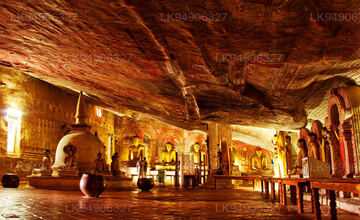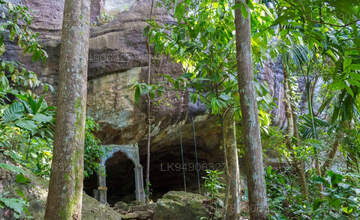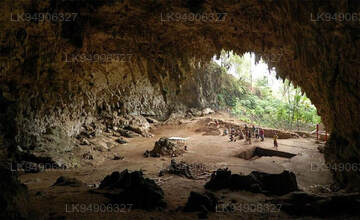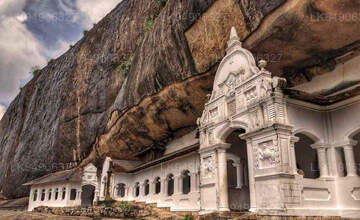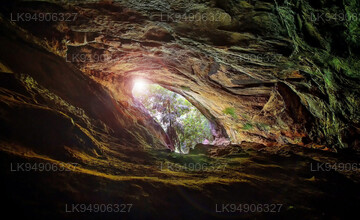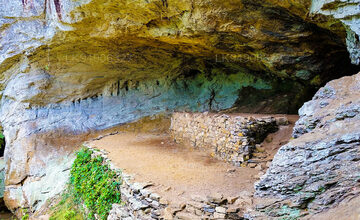Caves of Sri Lanka
Undoubtedly the most popular of all caves in Sri Lanka is the Dambulla Cave Temple, also known as the Golden Temple of Dambulla. Almost every round tour in Sri Lanka will cover this world heritage site, which is the largest and best-preserved cave temple complex in Sri Lanka.
Dambulla cave temple also known as the Golden Temple of Dambulla is a World Heritage Site (1991) in Sri Lanka, situated in the central part of the country. This site is situated 148 kilometres (92 mi) east of Colombo, 72 kilometres (45 mi) north of Kandy and 43 km (27 mi) north of Matale.
Dambulla is the largest and best-preserved cave temple complex in Sri Lanka. The rock towers 160 m over the surrounding plains. There are more than 80 documented caves in the surrounding area. Major attractions are spread over five caves, which contain statues and paintings. These paintings and statues are related to Gautama Buddha and his life. There are a total of 153 Buddha statues, three statues of Sri Lankan kings and four statues of gods and goddesses. The latter include Vishnu and the Ganesha. The murals cover an area of 2,100 square metres (23,000 sq ft). Depictions on the walls of the caves include the temptation by the demon Mara, and Buddha's first sermon.
Holding significant archaeological importance is this fairly large cave of Batatotalena. This cave shows human habitation since 32,000 BC and it is also believed that 10 skeletal remnants of old human remains of Sri Lanka have been excavated from here. One of whom was known as the “Homo sapiens Balangodensis”, or the Balangoda man, who was also said to have been responsible for creating the Horton Plains agriculture.
Cave measures: 49 feet high, 59 feet wide, 82 feet in length.
If you’ve got Kitulgala on your Sri Lanka tour itinerary, Belilena Cave is easily accessible from there. This cave proves evidence of Sri Lankan civilization from about 12,000 years ago, most likely occupied by a Balangoda man. Getting into the cave requires climbing on a rope ladder. Inside the cave mouth is a lake that is largely unexplored so be ready to come across fauna that is probably yet undiscovered!
Inhabited by about 250,000 bats is the famous Wavulpone Cave in Sri Lanka. This cave holds the largest known congregation of Bats on the island, and this is where it gets its name from – Wavulpone – meaning a dwelling of Bats.
Also an ancient Buddhist Monastery, Mahalenama Cave is believed to be the place where a preserved Vedda legend race known as Nittevo existed. The Nittevo tribe is said to be a dwarfish race of men living in the Mahalenama region and is believed to have been exterminated by the Veddas about 250 years ago. The identity of this folk has been very controversial because some believe that they were a lost Negritoes tribe, some think they were ape-men, while others believe they were an extinct bear species known as Rahu Valaha.
Aluvihara Cave Temple is where the Buddhist monks initially wrote the Tripitakas, previously preached exclusively by word of mouth. As a result, this Cave Temple holds a historical and cultural significance to Buddhism. The Temple’s original existence dates back to the 3rd century BC, during the reign of King Devanampiyatissa. It is now a gallery of antiques, preserving Buddha statues and other artifacts gifted by nearby Buddhist countries like Japan, Siam. China, Myanmar, and Cambodia.
The length of Sthripura Cave runs from Mathurata to Seetha Eliya, and the journey to the entrance of the cave is what makes it one of the most interesting caves of all. There are a series of three caves that are high enough to stand and walk in most areas. Legendary tales say that King Rawana used these caves to hide his beautiful Princess Seetha, whom he captured after defeating her husband, Prince Rama from India.
This uniquely named cave includes two caves, both located near a beautiful waterfall. There is a stream flowing through the first cave, which leads to a series of smaller caves and then comes the second main cave. Pannila Calcareous Caves are home to a large variety of birds, butterflies, fish, reptiles, and bats.
King Walagamba used Bogoda Cave as one of many hideouts when the south Indian forces invaded Sri Lanka. A unique feature of this cave is that it is believed to be part of a network of tunnels leading to other caves such as Rawana Ella Cave.

